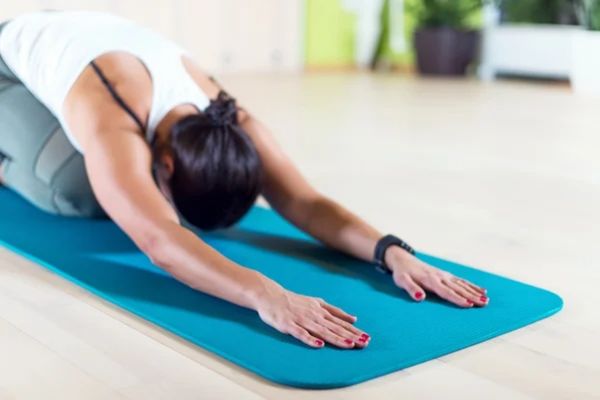In today’s fast-paced world, finding moments of calm and rejuvenation is essential for our overall well-being. Restorative yoga, a gentle and therapeutic practice, offers precisely that. Rooted in relaxation and mindfulness, restorative yoga focuses on deep rest, allowing the body to heal and restore itself. In this blog, we will explore the benefits, key principles, and some popular restorative yoga poses to help you create a serene and healing space within your yoga practice.
Understanding Restorative Yoga
Restorative yoga is a practice that emphasizes deep relaxation and rest. Unlike more dynamic yoga styles, restorative yoga involves holding poses for longer durations (typically 5-20 minutes) while using props such as blankets, bolsters, and blocks for support. The intention is to release tension, calm the nervous system, and promote a state of deep rest and renewal.

Restorative yoga provides an opportunity to slow down, cultivate mindfulness, and listen to your body’s needs. It encourages gentle stretching, conscious breathing, and an inward focus, allowing you to tap into your body’s natural healing abilities.
Benefits of Restorative Yoga
Restorative yoga offers numerous benefits for both the body and mind. Here are some of the key advantages:
a) Stress Reduction: Restorative yoga activates the body’s relaxation response, promoting a sense of calm and reducing stress levels. The gentle poses and deep breathing help release tension, lower blood pressure, and ease anxiety.
b) Physical Healing: By providing support and relaxation, restorative yoga allows the body to repair and rejuvenate. It can help relieve chronic pain, improve digestion, boost the immune system, and enhance overall physical well-being.
c) Mental and Emotional Balance: Restorative yoga nurtures the mind by promoting mental clarity, reducing mental fatigue, and improving sleep quality. It can also be beneficial in managing symptoms of depression, anxiety, and emotional imbalances.
d) Body Awareness: The slow-paced nature of restorative yoga encourages self-awareness and mindful attention to the body. By tuning into sensations, breath, and the present moment, practitioners can cultivate a deeper connection with themselves.

Key Principles of Restorative Yoga
Restorative yoga is based on a few fundamental principles that guide the practice:
a) Supportive Props: The use of props is essential in restorative yoga to create a comfortable and relaxed environment. Blankets, bolsters, straps, and blocks are utilized to provide support and help the body surrender into each pose.
b) Gentle Movement and Stillness: Restorative yoga focuses on slow, gentle movements to release tension and create space within the body. The emphasis is on finding a balance between effort and surrender, allowing the body to relax deeply.
c) Long Holds: Poses in restorative yoga are held for extended periods, allowing the body to sink into a state of relaxation and release. Longer holds enable the nervous system to calm down, promoting deep rest and healing.
c) Long Holds: Poses in restorative yoga are held for extended periods, allowing the body to sink into a state of relaxation and release. Longer holds enable the nervous system to calm down, promoting deep rest and healing.

Restorative Yoga Poses
Restorative yoga poses can be customized to suit individual needs. Here are a few popular poses to incorporate into your practice:
a) Supported Child’s Pose (Balasana): This pose gently stretches the hips and lower back while promoting deep relaxation. Place a bolster or folded blankets between your thighs and another one to support your torso as you fold forward.
b) Reclining Bound Angle Pose (Supta Baddha Konasana): This pose opens the hips and extends a gentle stretch to the inner thighs. Place a bolster or folded blankets behind your back and support your knees with blocks or bolsters. Relax your arms by your sides and allow your knees to fall open, creating a diamond shape with your legs.
c) Supported Bridge Pose (Setu Bandha Sarvangasana): This pose helps release tension in the lower back and opens the chest. Lie on your back with your knees bent and feet flat on the ground. Lift your hips and slide a bolster or folded blankets underneath your sacrum for support. Relax your arms by your sides and breathe deeply.
d) Legs-Up-The-Wall Pose (Viparita Karani): This gentle inversion promotes relaxation, improves circulation, and relieves tired legs. Sit sideways against a wall and swing your legs up, resting them against the wall. Support your lower back with a folded blanket or bolster. Relax your arms by your sides or place them on your belly for added grounding.
e) Supported Savasana (Corpse Pose): This final relaxation pose allows for complete surrender and deep rest. Lie on your back and support your head and knees with cushions or blankets for optimal comfort. Close your eyes, focus on your breath, and allow your body to melt into the support beneath you.

Restorative yoga provides a sanctuary for relaxation, self-care, and rejuvenation. By incorporating this gentle practice into your routine, you can experience profound physical, mental, and emotional benefits. It offers a way to counterbalance the stresses of daily life and create a nurturing space for healing and restoration.
Remember, restorative yoga is not about achieving perfect alignment or pushing your limits; it’s about surrendering, being present, and honoring your body’s needs. Explore different poses, listen to your intuition, and find what works best for you.
